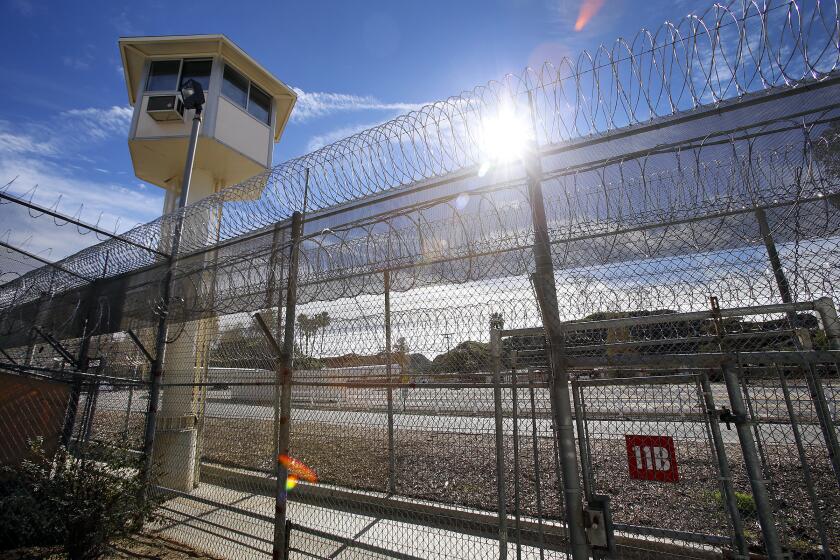A ‘brush with catastrophe’: Close call with Hughes fire stirs concerns about jail safety

- Share via
Through the glass window of the jail dayroom, Aaron Ortega caught a glance of a deputy’s computer screen. It was Jan. 22, and the local news was featuring footage of a new blaze that had broken out in Castaic late that morning.
As he and a few of the men around him kept watching, they learned the flames were those of the Hughes fire. Suddenly, the camera pulled back and Ortega realized the scene looked familiar.
“That’s across the street,” someone said in alarm. “That’s a fire!”
Then they realized they could smell the smoke. And there was nothing they could do.
The Hughes fire had begun that morning less than 5 miles from Ortega’s dorm in Pitchess Detention Center North, one of four lockups at the county’s sprawling Castaic jail complex. Ortega asked that his birth name not be used for fear of retaliation.
As the day went on, the fire grew to 10,000 acres and came so close that the facilities — and the roughly 4,700 inmates and 300 jailers inside them — all fell within an evacuation zone. Los Angeles County Sheriff’s Department officials moved a few hundred inmates from barracks to a sturdier concrete building, and scrambled to find or borrow more transport buses in case they needed to organize a larger-scale evacuation. At one point the flames crept within a mile of the jails before fire crews beat them back.
“I’m not willing to lose one person at that facility,” Sheriff Robert Luna said at the time.
But citing the advice of fire officials, the Sheriff’s Department did not empty out the lockups, writing in a news release that “after evaluating the strategic options,” life-safety risks and defensible space around the jails, it was better to shelter in place. The department likened the situation to the Franklin fire last year, during which Pepperdine University told students to take refuge in the library and other fire-resistant structures instead of fleeing campus.
The students survived then, just as the Castaic inmates did last month. But weeks later, justice advocates, lawyers and inmates’ families are still haunted by the what-ifs.
“But for the wind blowing in a different direction there could have been a catastrophe that would have been unrivaled in terms of carceral deaths,” Corene Kendrick, deputy director of the American Civil Liberties Union’s National Prison Project, told The Times this week.
She pushed back on the comparison to Pepperdine, pointing out that college students are not “locked in their dorm rooms” by university officials.
Over the weekend, the civil rights organization raised other lingering concerns in a post on its website, questioning whether there had been any air or water quality testing since the fire and urging county leaders to “demand effective evacuation plans” in the future.
In an emailed statement late Monday, the Sheriff’s Department said it has not done air quality testing in the jails, but the air filters have been inspected and serviced since the fire and water is routinely tested to ensure it meets state guidelines.
The Hughes fire broke out a little before 11 a.m., roughly five miles north of the Pitchess Detention Center. The Sheriff’s Department has struggled with a shortage of buses to transport inmates.
When the fire broke out a little before 11 a.m., Ortega was reading a book and occasionally glancing at the TV. In his unit, he said, jailers control the channel, often leaving it on sports or movies — but rarely news.
After losing interest in the book, he got up and took a shower, then sat down to wait for lunch, which arrived around 1 p.m., a little bit later than usual.
By that time, the flames had spread to more than 5,000 acres. The L.A. County Public Defenders Union issued a statement on social media calling for all of the Castaic facilities to be evacuated.
Yet it wasn’t until midafternoon that Ortega and the other men in his dorm caught sight of the deputy’s screen and realized there was a fire nearby. As soon as they did, they started calling home for more information and sharing what they’d learned.
When he found a free phone, Ortega dialed the number for his sister. She’d seen news coverage of the fire and was already concerned, wanting to know whether he’d been told anything about what was going on.
“Nothing,” he told her. “They just didn’t take us out to the yard because of the air quality.”
As the day went on, there were other disruptions. Weekly commissary orders didn’t arrive. The smoke grew thicker, and men started coughing. Ortega worried he wouldn’t make it to court the next day.
Nearby, at the high-security North County Correctional Facility, black clouds loomed outside the facility’s tiny windows. Jail officials locked down the facility and shut down the air circulation system to keep out the smoke.
One man — who asked not to be named for fear of retaliation — said some people started trying to figure out whether there was any way to break the windows and escape if the flames came too close. Rather than emptying the facility out, officials moved more people there, taking a few hundred men from the exposed barracks at Pitchess Detention Center South and moving them to the concrete safety of NCCF.
Still, advocates and inmates’ families fretted. Kimberlyn Ortega told The Times she felt “powerless” as she waited anxiously for her brother’s calls. Erica Lewis said she was “terrified” when she didn’t hear from her son, who was also in one of the Castaic jails when the fire broke out.
Just before dinner — which showed up late — Ortega said deputies handed out N95 masks. Some men tried to ask their jailers about the status of the fire and whether there were plans in place to evacuate.
“The deputies only said, ‘If it gets bad, we’ll move you guys,’” he recalled.
He’d heard about the bus shortage — roughly three-quarters of the department’s inmate transport buses were out of commission — and wondered if that kind of large-scale evacuation was really possible.
Incarcerated firefighters currently battling the Eaton Fire and are stationed at a base camp at the Rose Bowl.
It wasn’t until the 10 p.m. headcount that he realized there would be no evacuations that night. “That’s when I started to worry,” he said. “What if this building catches on fire? I don’t want to burn. I think I’d rather drown than burn.”
A little before midnight, he went to bed, covering his face with an extra shirt to keep out the smoke. By the time Ortega awoke in the morning, the worst of the danger had passed. The flames receded, and a little over a week later, fire officials fully contained the blaze.
In the end, the Sheriff’s Department said it scrounged up nearly 100 buses, borrowing from nearby counties, the state prison system and the local public transit system in case the winds shifted. This week, in a budget presentation before the Civilian Oversight Commission, sheriff’s officials said they are asking the county for $11 million to buy 11 more buses next year, in addition to the 20 new buses covered in the current budget.
But even that won’t be enough to fully replenish the department’s 82-bus fleet, which had dwindled to roughly two dozen operable buses by the end of last year.
“L.A. County escaped disaster by a half a mile. Our brush with catastrophe must spur local and state leaders to action,” the ACLU wrote in its blog post Saturday. “In L.A. County and around the country, alternatives to incarceration can shrink our grossly outsized carceral footprint, making it much easier for us to protect our communities from coming disasters.”
More to Read
Sign up for Essential California
The most important California stories and recommendations in your inbox every morning.
You may occasionally receive promotional content from the Los Angeles Times.












